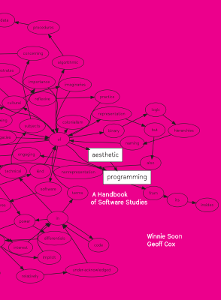
Aesthetic Programming: A Handbook of Software Studies
2020Typology category
computationalISBN-13
Authors
Publication year
Entry last updated
2024-12-01Publisher's description
Experimental aspects:
Aesthetic Programming asks “how power differentials are implicit in code in terms of binary logic, hierarchies, naming of the attributes, and how particular worldviews are reinforced and perpetuated through computation.” Taking on board the reflexive practice of aesthetic programming, the book is "offered as a computational object open to modification and reversioning." Aesthetic Programming thus exemplifies the potential of folding together technical experimentation with publishing processes and conceptual experimentation, demonstrating that publishing practice are inherently political.
The book is written in Markdown markup language. The authors and designers synchronised the markdown files using Git, a collaborative tool. The designers used Pelican CMS to transform the source files into HTML, rendered for online viewing. Polyfill paged.js, allows the designers to render PDF and print versions of the book from the HTML files. Multiple versions and formats of the book are thus generated from the same source files.
Following the initial publication in English, the authors set out to translate the book in collaboration with Taiwanese communities. Drawing inspiration from programming, they consider book translating as forking, experimenting with the politics of translation in a Taiwanese context, confronting, for example, the question “how the Chinese language model” used for machine translations, reproduces particular hegemonic worldviews."
Sarah Ciston and Mark C. Marino also forked Aesthetic Programming to add a new chapter, chapter 8.5 sandwiched between chapters 8 and 9 of the original book. Ciston and Marino described this as "participating in the development of their [Soon and Cox’s] book and the evolution of the codex book itself from a static product into an ongoing, iterative, process." Their fork both reuses and extends the original book and creates a dialogue between the two versions: their chapter, they write, does not "remedy a lack in the book, but adds its own insights, following the ‘yes-and’ ethos of its collaborating first authors".